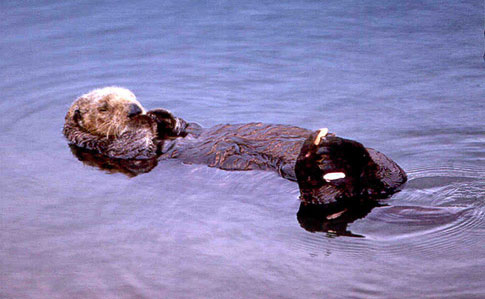 by Ned Rozell April 05, 2005
About five sea otters lived in Glacier Bay in 1995, but today more than 1,800 live there. Jim Bodkin and his colleagues at the USGS Alaska Science Center in Alaska have studied the sea otter's recent emergence in Glacier Bay. A biologist, Bodkin started the study in 1993, two years before otters showed up in the bay. He and other researchers knew otters were nearby at the time and would probably soon move in. Glacier Bay National Park, located in Southeast Alaska, has been in existence for about 250 years, when huge glaciers at the mouth of the bay began retreating.  with a growing sea otter population. Photo by Jim Bodkin
Starting in 1965, the Alaska
Department of Fish and Game captured otters on Amchitka Island
in the Aleutians and some in Prince William Sound, releasing
412 off the coast of Southeast Alaska, a few of those off Cape
Spencer near Glacier Bay. In the mid-1990s, some otters found
their way into Glacier Bay. At the same time, sea otters in the Aleutians and other areas of Alaska have been decreasing. Some scientists think the population crash is due to killer whales eating more sea otters in the Aleutians, possibly because traditional killer whale prey, such as large whales and sea lions, have also dwindled in the Aleutians. Terrie Williams of the University of California and Jim Estes of USGS authored a recent study in the journal Ecology showing that male sea otters contained almost 62,000 calories when eaten whole, a decent percentage of the 243,000 calories an average male killer whale needs to survive each day. Killer whales also hunt in Glacier Bay, but they don't seem to be slowing down the otters. People have seen killer whales eat otters in Southeast Alaska, but other marine mammals that killer whales eat are not as rare in Southeast as they are in the Aleutians and that perhaps takes the pressure off the otters, Bodkin said. While the possible otter/killer whale connection in the Aleutians is intriguing, Bodkin and his colleagues are more interested in looking at the sea otter as a predator and how its sudden emergence in Glacier Bay will affect other living things. Clams in Glacier Bay might be fewer and smaller after a few years, and the distribution of sea birds, fish and some other mammals could change there with the sea otter feasting on local crabs, sea urchins and other shellfish. Because scientists began the study before otters were in Glacier Bay and sea otters haven't yet occupied the entire bay, the researchers have been able to document the plants and animals of the bay before otters. While other scientists study the otters in the Aleutians as victims of changes that began with the 1741 passage of Bering's ship, the St. Peter, Bodkin will look at Glacier Bay otters as agents of change in a young ecosystem.
|